Description
The Imperial Cathedral in Königslutter (Germany) is one of the most important romanesque buildings in Germany. It was founded in 1135 by Emperor Lothar III as a Benedictine abbey church and burial church for himself and his family. After Lothar's death, the cathedral was completed under Henry the Lion. It is a cruciform basilica of enormous dimensions for that period, measuring about 75 m long and 18 m high.
At the end of the 19th century an extensive restoration of the church was decided. This also included a new painting of the interior of the church, as the medieval church painting had been painted over with yellow paint. The artistic paintings from this restauration are today considered an important document of the end of the 19th century.
In the course of this restoration a new organ was installed as well. This organ was built by one of the leading german organ builders of the time, P. Furtwängler und Hammer from Hanover. At that time, this company could already look back on a long tradition of organ building. It was founded in 1838 by Phillip Furtwängler,, later his sons took over the business. In 1883 the organ builder Emil Hammer became a partner in the company and the name was changed to P. Furtwängler and Hammer.
The organ corresponds to the romantic sound ideal of its time. Its sound is characterized by numerous stops in a variety of timbres at 16', 8' and 4' as well as by the typical degressive terrace dynamics, in which the volume decreases from the lower manual upwards. Thus, for most stops there is an equivalent with a graded sound volume in each manual. This enables an almost stepless dynamic climax and anticlimax, which according to the german-romantic tradition is performed using the labial stops.
The company Furtwängler und Hammer acquired an excellent reputation through the high quality of its organs, many of which still play today.
The organ in the Kaiserdom was built in 1892 as Opus 286 and today has 44 stops on 3 manuals and pedal. The key action is mechanical-pneumatic, in the Hauptwerk division a mechanical action controls pneumatic Barker levers, which in turn open the valves of the organ pipes mechanically. This type of action was also used by Aristide Cavaillé-Coll, it allows a very precise and effortless playing, but there is no direct mechanical connection between the keyboard and the valves. This organ is an instrument with a cone valve chest, a typical wind chest construction of the German-Romantic organ building style, in which all the pipes of a stop are placed on a stop-channel and controlled by individual valves. In contrast to the slider chest construction, not only one valve per key is required, but for each stop one valve per key is needed. Hence - in contrast to the slider chest - every single pipe receives the full wind.
In the 1940s the german Orgelbewegung did not stop at this organ either, and some changes were made in order to come closer to the baroque sound ideal prevailing at that time. For example, the Clarinette 8' was replaced by a Krummhorn 8', and the Progressive Harmonica (Mixture) in the Seitenwerk (manual II) was replaced by a baroque Scharff. In 1984 the mechanical action was replaced by an electric one.
In the 1990s, considerable damage was found to the paintings in the church and an Kaiserdom extensive renovation was planned. The beautiful painting of the 19th century was completely restored to its original colour. In the course of this comprehensive renovation of the church in the years 2008 to 2010, the organ was also subjected to a thorough overhaul. It was restored to its historical sound of 1892 by the organ-building company Hartwig Späth (Freiburg). During the electrification of the organ in 1984, the components of the mechanical action had fortunately been stored, so that the original mechanical-pneumatic action could now be restored and reinstalled.
After this restoration, the large Furtwängler and Hammer organ is now considered an outstanding sound monument and one of the most important romantic organs in northern Germany.
Disposition:
|
Hauptwerk (I) C-f''' (ext. to g''')
Großgedeckt 8'
Hohlflöte 8'
Gedecktflöte 4'
Gambe 8'
Bordun 16'
Quinte 2 2/3'
Principal 8'
Octave 4'
Principal 16'
Gemshorn 4'
Octave 2'
Cornett 3-4 fach
Mixtur 3-5 fach
Trompete 8'
II-I
|
Seitenwerk (II) C-f''' (ext. to g''')
Doppelflöte 8'
Gemshorn 8'
Rohrflöte 4'
Fugara 8'
Principal 8'
Quintatön 16'
Viola 4'
Harmonieflöte 2'
Nazard 2 2/3'
Progr.Harmonica 2-4f 2 2/3'
Clarinette 8'
Tremulant
III-II
|
|
Pedal C-d' (ext. to f')
Subbaß 16'
Flötbaß 8'
Cello 8'
Violon 16'
Prinzipalbaß 16'
Oktavbass 8'
Quintenbass 10 2/3'
Octave 4'
Posaune 16'
Trompetbaß 8'
I-P
|
Echowerk (III) C-f''' (ext. to g''')
Salicional 8'
(undulating from c)
Liebl. Gedeckt 8'
Flöte travers 8'
Aeoline 8'
Zartflöte 4'
Aeoline 16'
Geigenprincipal 8'
Violine 4'
Oboe 8'
|
Details
The organ was recorded in 2018 with high-quality microphones in four-channel technology. One pair of microphones was positioned at the height of the organ facade (approx. 12m high) and about 10m away from the organ. These microphones deliver a high proportion of direct sound, but also have a significant reverberation component. This makes the organ sound very clear. In the sample set, these channels are labeled Direct. The second pair was placed at a typical listener position and delivers a significantly higher reverb portion, the response of the organ sounds somewhat less precise. In the sample set these channels are called Ambient.
For an optimal spatial impression, at least three release layers (staccato, portato and long notes) were recorded for each pipe. The blower noise as well as action and stop control sounds were also recorded.
The recordings were made in 24bit/96kHz without any filtering. The processing of the samples was carried out with our own developed sample processing tools, whereby in particular our special noise removal procedure is to be mentioned. This is optimized for the characteristics of pipe organ sounds and enables a previously unknown quality of noise removal without impairing the sound characteristics.
The sample set faithfully reproduces the organ and its playing aids in Hauptwerk. The manual compass has been extended to g''' in the manuals and f'' in the pedal.
Special Features of the Sampleset
In the following, a few special features of the organ and their implementation in the sample set will be described:
Couplers
The manual coupler II/I couples through, i.e. if both the pedal coupler I/P and the manual coupler II/I are drawn, the second manual is also coupled to the pedal, i.e. you get II/P in addition. The coupler III/II, on the other hand, does not couple through, so the third manual can only be coupled to the second, but not to the first or the pedal.
Expression mechanism (echo division)
The original organ does not feature a swellshoe that allows continuous movement. Instead there is a latching foot lever to control the expression. Opening and closing takes a short time, a continuously adjustable control is not possible. In the sample set, both the original operation with a switch (e.g. piston) as well as with an analog swell shoe is possible. For operation with a switch, the foot lever on the console screen must be connected to a piston or similar on the console. If analog operation is desired, the LED display on the stop page is linked to an analog pedal. The two possibilities can also be combined, it is possible to connect both elements to the console and use them as desired. The analog (LED) display on the screen will also follow the foot lever, but not vice versa. After pressing the foot lever one needs to wait a few seconds before the analog control can be used again.
Bottom octave of Gemshorn 8' and Salicional 8'
In the bottom octave of the Gemshorn 8' in manual II the pipes from the Doppelflöte 8' are sounding (and similar for Salicional 8' and Lieblich Gedackt 8' in manual III). There are however separate valves for these pipes for both stops which causes them to speak a little bit louder when both stops are drawn at the same time. This is faithfully reproduced in the sampleset.
Undulation
The Salicional 8' in the echo division (manual III) is voiced undulating.
Tremulant
The sample set features special tremulant samples, i.e. each individual pipe of the Seitenwerk has been recorded also with tremulant on. This yields the most realistic sounding tremulant sound especially for organs with significant amount of reverb. However, there are also drawbacks: On the one hand the beats of the tremulant are not synchronised across pipes. Also it is not possible to adjust the tremulant speed. Finally it is not possible to switch while a note is sounding. There are two options for this, which are controlled by the Tremulant Retrigger switch on the Controls page: When the switch is OFF, switching the tremulant ON or OFF will only affect notes which are played AFTER switching, when it is in the ON position, notes sounding at the moment when the tremulant is switched will be interrupted and retriggered immediately, now sounding with the new tremulant setting. Depending on the speech of the pipe this will be more or less audible. For these reasons the sampled tremulant is best suited for solo voices.
Fixed combinations
There are four fixed combinations that allow quick registration changes, Piano, Mezzoforte, Forte and Tutti. These are controlled using the pistons below the Hauptwerk keyboard. When a combination is activated the stop drawknobs have no effect. Pushing the Handregistratur piston or foot lever will activate the manual registration again. The fixed combinations are implemented with the historically correct registrations.
Piano-Pedal, Forte-Pedal
The Piano-Pedal foot lever deactivates all pedal stops, so that only stops from coupled keyboards are sounding when playing on the pedal board. The Forte-Pedal foot lever activates the stops again. This function is working for hand registration as well as fixed combinations.
Surround
The sample set is produced with four channel audio, divided in direct and ambient channels. In order to achieve best results these should sound via separate speaker channels. The two sliders on the Controls-page allow to adjust the direct and ambient channels separately.
Special sounds
The sound of the blower as well as tracker and stop action can be switched ON or OFF with the corresponding switches on the Controls-page. These are active on first load of the organ and remember their last status when unloading the sample set. The volume level of these sounds matches the original level and can be adjusted using Hauptwerk's integrated voicing controls.
Tuning
Using Hauptwerk's Original Tuning setting the organ is sounding with exactly the same tuning as when it was recorded, but set to a base pitch of a1=443Hz. This corresponds to the original base pitch of the organ. If you use one of the tempered tunings available in Hauptwerk (e.g. equal or middle tone), the organ will be tuned very precise to this tuning. Such precise tuning may however sound a little sterile, which is why Hauptwerk includes a random tuning function when loading.
This random detuning function built into Hauptwerk can unfortunately not be used, as it is still not possible to ensure that matching front and rear samples are synchronously detuned (this is a limitation in Hauptwerk and affects all available multichannel sample sets). The result is usually not very pleasing. Therefore the corresponding parameters in the sample set are set to 0, so that the setting "random detuning" of Hauptwerk has no effect. Instead, the sample set contains its own pseudo-random detuning function. The degree of detuning can be adjusted with the slider on the Controls page. The values are randomly determined for each pipe, but are hard-coded in the definition file and cannot be changed by the user.
Virtual Console
The virtual console consists of various screen pages that have been optimized for operation with touchscreens. The divided drawknob panels (right/left side) are available in both portrait and landscape orientation for different monitor arrangements. Switching between the two formats is done automatically in Hauptwerk, depending on the size of the corresponding screen windows. The following screen pages are available:
Console (landscape only)
This display page is not intended to be used to actually control the organ, but to give the organist an impression of the real console. For this page a photograph of the console has been provided with animated stops. Due to the small size the stop names are however not readable.
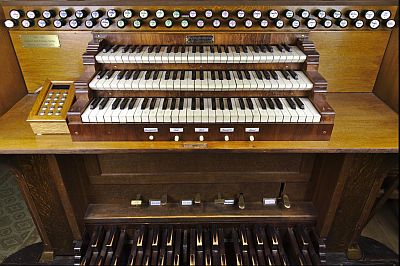
Stops page (landscape only)
This display page contains all organ controls except the keyboards and the pedal. The page has been designed to be easy to read. This screen page is ideal for operating the sample set when only one touch screen is available. The arrangement of the stops within the manuals corresponds to the original.
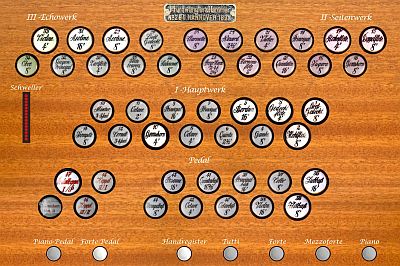
Left and Right drawknob pages (landscape and portrait)
These pages are intended for the operation of the organ with two touchscreens. They contain the same elements as the main page, divided into a left and a right side. The operability of these pages is particularly good, as the elements are very large. Here, too, the arrangement of the stops corresponds to the original.
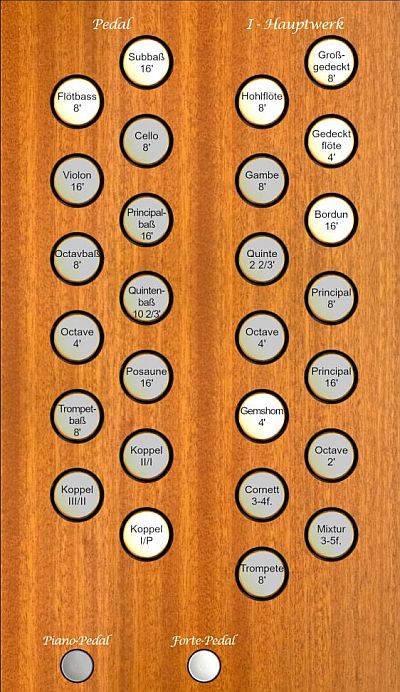
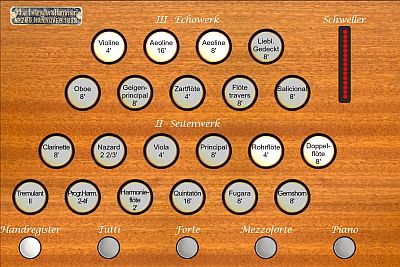
Controls (landscape only)
This page is used for various settings. These are the balance between the direct and ambient channels as well as the control of the different special sounds.
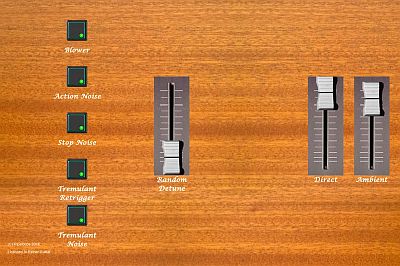
Registation of the fixed combinations
Hauptwerk (M I):
| |
P |
MF |
F |
T |
| Großgedackt 8' |
x |
x |
x |
x |
| Hohlflöte 2' |
x |
x |
x |
x |
| Gedacktflöte 4' |
|
x |
x |
x |
| Gambe 8' |
x |
x |
x |
x |
| Bordun 16' |
x |
x |
x |
x |
| Quinte 2 2/3' |
|
x |
x |
x |
| Principal 8' |
|
x |
x |
x |
| Octave 4' |
|
x |
x |
x |
| Principal 16' |
|
|
x |
x |
| Gemshorn 4' |
|
|
x |
x |
| Octave 2' |
|
|
x |
x |
| Cornett |
|
|
x |
x |
| Mixtur |
|
|
|
x |
| Trompete 8' |
|
|
|
x |
| Koppel II - I |
|
|
|
x |
Seitenwerk (M II):
| |
P |
MF |
F |
T |
| Doppelflöte 8' |
x |
x |
x |
x |
| Gemshorn 8' |
|
x |
x |
x |
| Rohrflöte 4' |
x |
x |
x |
x |
| Fugara 8' |
x |
x |
x |
x |
| Principal 8' |
|
x |
x |
x |
| Quintatön 16' |
|
x |
x |
x |
| Viola 4' |
|
x |
x |
x |
| Harmonieflöte 2' |
|
|
x |
x |
| Nasard 2 2/3' |
|
|
x |
x |
| Progr. Harmonika |
|
|
|
x |
| Clarinette 8' |
|
|
|
x |
| Koppel III - II |
|
|
|
|
Echowerk (M III):
| |
P |
MF |
F |
T |
| Salicional 8' |
x |
x |
x |
x |
| Liebl. Gedeckt 8' |
x |
x |
x |
x |
| Traversflöte 8' |
x |
x |
x |
x |
| Aeoline 8' |
|
x |
x |
x |
| Zartflöte 4' |
x |
x |
x |
x |
| Aeoline 16' |
|
x |
x |
x |
| Geigenprincipal 8' |
|
|
x |
x |
| Violine 4' |
|
|
x |
x |
| Oboe 8' |
|
|
|
x |
Pedal:
| |
P |
MF |
F |
T |
| Subbass 16' |
|
x |
x |
x |
| Flötenbass 8' |
x |
x |
x |
x |
| Cello 8' |
x |
x |
x |
x |
| Violon 16' |
x |
x |
x |
x |
| Principal 16' |
|
x |
x |
x |
| Octavbass 8' |
x |
x |
x |
x |
| Quintbass 10 2/3' |
|
|
x |
x |
| Octave 4' |
|
|
x |
x |
| Posaune 16' |
|
|
|
x |
| Trompete 8' |
|
|
|
x |
| Koppel I - P |
|
|
x |
x |
Requirements
Licence Inform.
The sample set requires a very powerful Windows or Apple Mac-OS computer with a current 64-bit operating system and the Hauptwerk™ software (Advanced Edition from version 4.2.1). For an optimal result a sufficiently powerful CPU (e.g. modern Hexacore CPU) and sufficient main memory (RAM) are crucial. The following table shows the memory requirements in MB for the samples with different loading options (with sample compression):
| |
all channels |
only front |
| 16 bit |
10.2 GB |
5.6 GB |
| 24 bit |
21.4 GB |
10.9 GB |
The compression of the samples used by Hauptwerk is lossless, i.e. loading with the "compressed" option does not cause any loss of quality. However, playing the set requires a bit more CPU power. The best quality is achieved when loading with 24-bit resolution, but with a very small loss in quality you can also select 16-bit resolution. Since this can be set in Hauptwerk individually for each rank, it is possible to adjust the loading options individually to the available main memory.
For installation of the sample set, about 30 GB of free space on the hard disk is required.
Download and installation
The sample set is delivered exclusively as a download (approx. 22 GB). Detailed installation instructions for your Hauptwerk version can be found in the Hauptwerk Main User Guide. You can access it in Hauptwerk via the Help menu.
During the installation the licence agreement is displayed, which you can also find in below. You can only continue with the installation if you accept the licence agreement.
For Hauptwerk up to version 4.x we will send you a personalized Organ Definition File (ODF) In order to unlock the sample set. This file displays the text "licenced to <Your Name>"on the Controls-page. Since the file is encrypted, this text cannot be changed or removed. You will receive this file shortly after your order by email from Pipeloops. If you have purchased the sample set from a retailer, the retailer must notify us accordingly. The personalized ODF is installed in Hauptwerk as usual via the "Install" entry in the "File" menu of the Hauptwerk software.
The ODF of the full version must be installed IN ADDITION to the free trial version, which contains all samples and graphics.
Starting from Hauptwerk version V we are using the iLok licencing system for this sample set. You can download the complete set from our server, however, you will need to activate a licence to use it with Hauptwerk. An activation code will be sent to you normally within 24 hrs of your purchase. A free 14-day trial licence is also available on request.
Licence Conditions
The licence conditions for our sample sets conditions can be found here.

